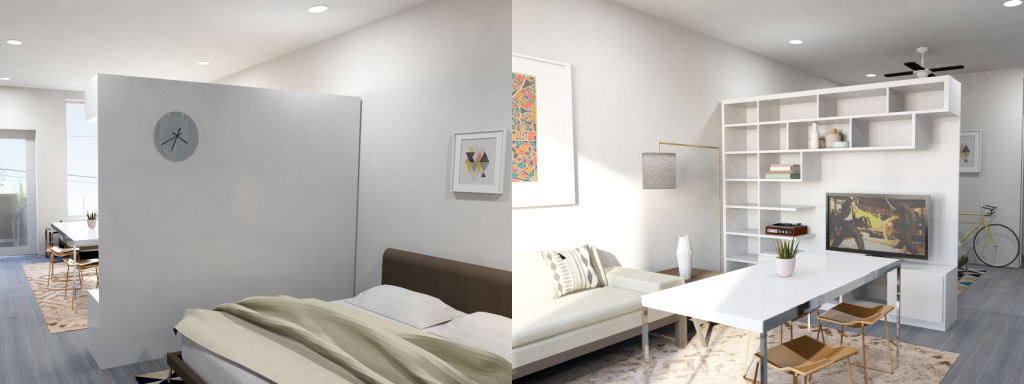Sponsored Post – from Fourth&
This post was written by Priyunka Maheshwari, Marketing Coordinator at Capsa Ventures, the developer of a new sustainability-focused condo building that is currently under construction in east Austin.
So what if your home is only 500 square feet? A 500-square-foot apartment would be considered quite spacious in cities like New York, London, Paris, and Tokyo. And if the residents of these glamorous cities can make their small homes look like palaces, you certainly can. It’s one part illusion, two parts good design. (Plus, living smaller can help you reduce your personal carbon footprint, allowing you to help the environment and save money, all at the same time).
1. Use different color schemes for each “room”
If you have a small space, some regions of your home might bleed together. Your entryway might open directly into the kitchen, which is attached to a small living and dining area. In order to help your brain separate these areas visually, use coordinating colors to give each room a different feeling. For example, you might use white paint, black-and-white posters, and ceramic décor in the kitchen but throw navy cushions and an aqua lacquered coffee table into the living room. Even though these two spaces are literally a step away from each other, you will be able to “see” where the divide is.
2. Buy full-size décor instead of small pieces
You’re going to feel threatened by your small space. But if I buy a large table, that leaves no space for anything else, you might think. You’re correct. Small homes require trade-offs, and you won’t be able to buy every piece of furniture you added to your Pottery Barn cart. But don’t make the mistake of buying smaller versions of lots of things. If you forego a large sofa in order to buy a medley of cute chairs, an ottoman, and that love seat you really wanted, you’re going to end up with clutter. And clutter is even more noticeable in a small space.
Combat this by buying full-size pieces, which will actually fill out your home nicely. There’s an unofficial guideline called the “cantaloupe rule,” which states that you should avoid accents that are smaller than a cantaloupe. All those tiny knick-knacks you picked up on sale are actually making your home look like a museum of junk. Instead, if you have tiny treasures, combine them together in a basket, or simply rotate which ones are displayed each month.
3. Invest in glass and mirrors
Glass can help you combat the clutter effect by simply blending in. A bright-colored vase on top of a dark desk can look busy, but substitute a glass desk and voilà! Fourth&, which opens this November in east Austin, offers 500-square foot efficiency units featuring big windows, glass balcony doors, and high ceilings–a winning combination when it comes to creating openness and space.
You can also create a more inviting look with a large mirror, which will create the illusion of more space. Pro tip -putting the mirror behind a lamp is even more magical, because the light will reflect and magnify across the entire room.
4. Install wall dividers or curtains
Similar to the first tip, if you want to break up a boxy apartment, do so by enclosing some elements. It sounds counter-intuitive–why should hiding some areas help enlarge your overall home? Rooms, even if they are homemade, prevent you from seeing the entire space at once. The result? Your brain doesn’t immediately recognize what’s behind the wall. You could have a walk-in closet behind there! Or maybe a whole other bedroom. Perhaps the entrance to Narnia. The point is, the not-knowing will make your home look less like a cramped jail cell. Take the example above from a Fourth& efficiency unit. A large bookshelf creates an ad hoc barrier to split one room into both a living room and bedroom. Bonus – partitions also allow you some privacy if you have a guest over.
5. Leave some space empty
Again, you’ll want to fight this one. You already have a limited amount of space to work with, and further restrictions on where you can put stuff means more trade-offs. But bear with me–these compromises are for a good reason. If you fill up every shelf and put a piece of furniture against every wall, your apartment will look like you’ve stuffed it to the brim. Even if all the pieces are tasteful and curated, a full home makes you seem like a hoarder. Small apartments look best when they’re minimalist. Leave some shelves empty, some countertops clear, and some wall space unused. Your small lifestyle will look more and more like a bold, savvy choice.
Not convinced that you can live large in a tiny home? Drop by Fourth& and tour the model efficiency unit to see how far 500 square-feet can really go!
Please note – editorials and sponsored posts are written by guest writers to inform and educate the community on a variety of different viewpoints, as well as to share information about local eco-friendly businesses and organizations. However, they do not necessarily reflect the opinions of the Austin EcoNetwork.



